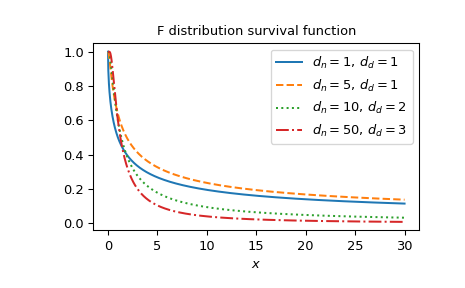scipy.special.fdtrc#
- scipy.special.fdtrc(dfn, dfd, x, out=None) = <ufunc 'fdtrc'>#
F 生存函数。
返回互补 F 分布函数(密度从 x 到无穷大的积分)。
- 参数:
- dfnarray_like
第一个参数(正浮点数)。
- dfdarray_like
第二个参数(正浮点数)。
- xarray_like
参数(非负浮点数)。
- outndarray, optional
函数值的可选输出数组
- 返回:
- y标量或 ndarray
具有参数 dfn 和 dfd 在 x 处的互补 F 分布函数。
参见
fdtrF 分布累积分布函数
fdtriF 分布逆累积分布函数
scipy.stats.fF 分布
注释
使用正则化不完全 Beta 函数,根据公式:
\[F(d_n, d_d; x) = I_{d_d/(d_d + xd_n)}(d_d/2, d_n/2).\]Cephes [1] 例程
fdtrc的包装器。 F 分布也可作为scipy.stats.f使用。 与scipy.stats.f的sf方法相比,直接调用fdtrc可以提高性能(参见下面的最后一个示例)。参考文献
[1]Cephes 数学函数库,http://www.netlib.org/cephes/
示例
计算
dfn=1和dfd=2在x=1处的函数值。>>> import numpy as np >>> from scipy.special import fdtrc >>> fdtrc(1, 2, 1) 0.42264973081037427
通过为 x 提供 NumPy 数组来计算多个点的函数值。
>>> x = np.array([0.5, 2., 3.]) >>> fdtrc(1, 2, x) array([0.5527864 , 0.29289322, 0.22540333])
绘制多个参数集的函数图。
>>> import matplotlib.pyplot as plt >>> dfn_parameters = [1, 5, 10, 50] >>> dfd_parameters = [1, 1, 2, 3] >>> linestyles = ['solid', 'dashed', 'dotted', 'dashdot'] >>> parameters_list = list(zip(dfn_parameters, dfd_parameters, ... linestyles)) >>> x = np.linspace(0, 30, 1000) >>> fig, ax = plt.subplots() >>> for parameter_set in parameters_list: ... dfn, dfd, style = parameter_set ... fdtrc_vals = fdtrc(dfn, dfd, x) ... ax.plot(x, fdtrc_vals, label=rf"$d_n={dfn},\, d_d={dfd}$", ... ls=style) >>> ax.legend() >>> ax.set_xlabel("$x$") >>> ax.set_title("F distribution survival function") >>> plt.show()

F 分布也可作为
scipy.stats.f使用。 直接使用fdtrc比调用scipy.stats.f的sf方法快得多,特别是对于小型数组或单个值。 要获得相同的结果,必须使用以下参数化:stats.f(dfn, dfd).sf(x)=fdtrc(dfn, dfd, x)。>>> from scipy.stats import f >>> dfn, dfd = 1, 2 >>> x = 1 >>> fdtrc_res = fdtrc(dfn, dfd, x) # this will often be faster than below >>> f_dist_res = f(dfn, dfd).sf(x) >>> f_dist_res == fdtrc_res # test that results are equal True